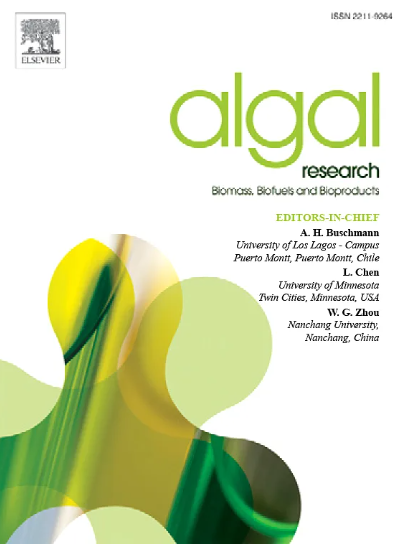利用动态模型优化platarthrospira C1半连续培养生产藻蓝蛋白
IF 4.5
2区 生物学
Q1 BIOTECHNOLOGY & APPLIED MICROBIOLOGY
Algal Research-Biomass Biofuels and Bioproducts
Pub Date : 2025-06-18
DOI:10.1016/j.algal.2025.104157
引用次数: 0
摘要
平节螺旋藻(Arthrospira platensis) c -藻蓝蛋白(C-PC)的产生受氮有效性的强烈影响。在本研究中,我们利用之前建立的基于ode的动态模型,模拟了0.25 ~ 2.0 mM N对A. platensis C1的C-PC和生物量生产的影响。与实验数据的比较表明,该模型具有较低的RMSE值和较高的相关系数,在批处理和半连续系统中都具有较高的预测精度。模型导向的半连续工艺优化表明,初始铵浓度为1.8 mM N,收获间隔为36 h,显著提高了C-PC含量,达到约28% DW。该模型为管理氮水平和优化栽培间隔以最大化C-PC含量提供了一个强大的框架。这些见解强调了该模型作为优化C-PC生产工具的实用性,同时促进了微藻培养的可持续实践。本文章由计算机程序翻译,如有差异,请以英文原文为准。

Optimizing semi-continuous cultivation of Arthrospira platensis C1 for phycocyanin production using dynamic modeling
The production of C-phycocyanin (C-PC) from Arthrospira platensis is strongly influenced by nitrogen availability. In the present study, we used our previously developed ODE-based dynamic model to simulate the effects of ammonium concentrations ranging from 0.25 to 2.0 mM N on C-PC and biomass production in A. platensis C1. Comparisons with experimental data demonstrated the model's high predictive accuracy in both batch and semi-continuous systems, supported by low RMSE values and high correlation coefficients. Model-guided optimization of semi-continuous processes revealed that an initial ammonium concentration of 1.8 mM N, with a 36 h harvesting interval, significantly enhanced the C-PC content to approximately 28 % DW. This model offers a robust framework for managing nitrogen levels and optimizing cultivation intervals to maximize C-PC content. These insights underscore the model’s utility as a tool for optimizing C-PC production while promoting sustainable practices in microalgae cultivation.
求助全文
通过发布文献求助,成功后即可免费获取论文全文。
去求助
来源期刊

Algal Research-Biomass Biofuels and Bioproducts
BIOTECHNOLOGY & APPLIED MICROBIOLOGY-
CiteScore
9.40
自引率
7.80%
发文量
332
期刊介绍:
Algal Research is an international phycology journal covering all areas of emerging technologies in algae biology, biomass production, cultivation, harvesting, extraction, bioproducts, biorefinery, engineering, and econometrics. Algae is defined to include cyanobacteria, microalgae, and protists and symbionts of interest in biotechnology. The journal publishes original research and reviews for the following scope: algal biology, including but not exclusive to: phylogeny, biodiversity, molecular traits, metabolic regulation, and genetic engineering, algal cultivation, e.g. phototrophic systems, heterotrophic systems, and mixotrophic systems, algal harvesting and extraction systems, biotechnology to convert algal biomass and components into biofuels and bioproducts, e.g., nutraceuticals, pharmaceuticals, animal feed, plastics, etc. algal products and their economic assessment
 求助内容:
求助内容: 应助结果提醒方式:
应助结果提醒方式:


